
Kennedia nigricans, commonly known as black kennedia, is a species of flowering plant in the family Fabaceae and is endemic to the south-west of Western Australia. It is a trailing or twining shrub or climber with trifoliate leaves and black and yellow-orange flowers.

Lasiopetalum floribundum, commonly known as free flowering lasiopetalum, is a species of flowering plant in the family Malvaceae and is endemic to the south-west of Western Australia. It is an erect or spreading shrub with hairy young stems, egg-shaped leaves and pale pink, mauve or white flowers.

Pultenaea tenuifolia, commonly known as slender bush-pea, is a species of flowering plant in the family Fabaceae and is endemic to southern Australia. It is a spreading or low-lying to prostrate and mat-forming shrub with hairy branches, narrow lance-shaped leaves, and yellow to orange and red, pea-like flowers.

Eremophila phyllopoda is a flowering plant in the figwort family, Scrophulariaceae and is endemic to Western Australia. It is an erect or spreading shrub, sometimes round or flat-topped with sticky, hairy leaves and flowers ranging in colour from pink or lilac to purple.

Eremophila platythamnos, commonly known as desert foxglove, is a flowering plant in the figwort family, Scrophulariaceae and is endemic to Australia. It is an erect shrub with short, broad leaves and purple, mauve, blue or pink flowers.

Eremophila spathulata, commonly known as spoon-leaved eremophila, is a flowering plant in the figwort family, Scrophulariaceae and is endemic to Western Australia. It is a shrub with many tangled branches, stiff, grey, spoon-shaped leaves, reddish-purple sepals and blue, pink or violet petals.
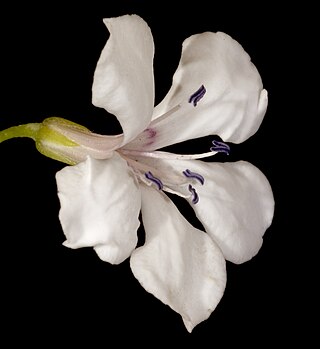
Marianthus candidus, commonly known as white marianthus, is a species of flowering plant in the family Pittosporaceae and is endemic to the south-west of Western Australia. It is a twining shrub or climber with elliptic leaves and white flowers arranged in groups of twenty to thirty and becoming fawn or pink as they age.
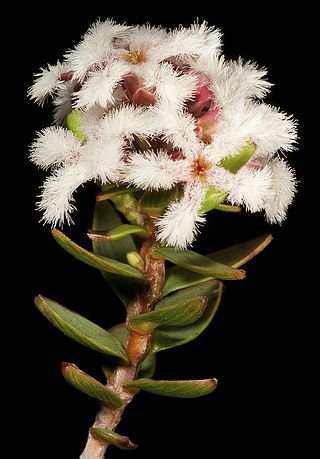
Leucopogon polymorphus is a species of flowering plant in the heath family Ericaceae and is endemic to near-coastal areas of south-western Western Australia. It is a shrub with egg-shaped to lance-shaped or almost linear leaves and short, dense spines of white, tube-shaped flowers.

Lasiopetalum drummondii is a species of flowering plant in the family Malvaceae and is endemic to the south-west of Western Australia. It is an erect, slender shrub with many densely hairy stems, egg-shaped or oblong leaves and white, pink and red flowers.
Lasiopetalum monticola is a species of flowering plant in the family Malvaceae and is endemic to the south-west of Western Australia. It is an erect, slender or straggling shrub with densely hairy branchlets, leaves and flowers, egg-shaped leaves and pink, cream-coloured or white flowers.
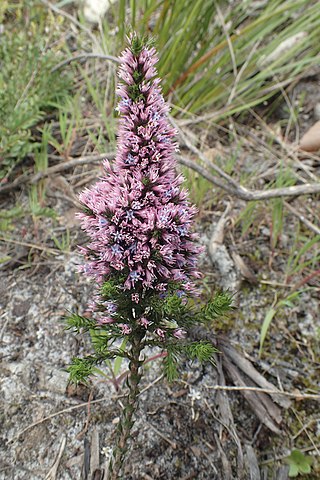
Andersonia caerulea, commonly known as foxtails, is a species of flowering plant in the family Ericaceae and is endemic to the southwest of Western Australia. It is an erect or spreading to low-lying shrub with variably-shaped leaves and pink and pale blue flowers, sometimes in spike-like groups.
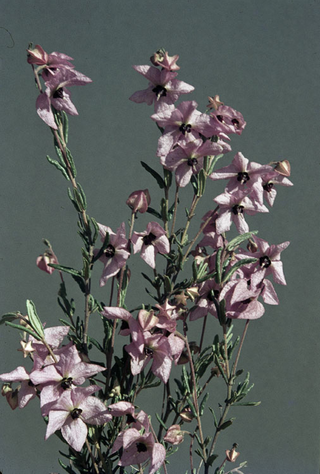
Guichenotia sarotes is a species of flowering plant in the family Malvaceae and is endemic to the southwest of Western Australia. It is a spindly, low-growing shrub with densely hairy new growth, hairy, greyish, linear leaves and pink to purple flowers arranged in loose groups of two to six.

Androcalva procumbens is a species of flowering plant in the family Malvaceae and is endemic to central New South Wales. It is a prostrate shrub covered with star-shaped hairs, and with slender, trailing stems, egg-shaped to narrowly egg-shaped or lance-shaped leaves with scalloped or lobed edges, and clusters of 4 to 10 white, pink and yellow flowers.
Androcalva perlaria, commonly known as pearl-like androcalva, is a species of flowering plant in the family Malvaceae and is endemic to a restricted area of southern Western Australia. It is a rounded shrub with egg-shaped leaves, the narrower end towards the base, and heads of three to nine white and pinkish flowers.

Guichenotia micrantha, commonly known as small flowered guichenotia, is a species of flowering plant in the family Malvaceae and is endemic to the south-west of Western Australia. It is a low, compact shrub with linear to narrowly egg-shaped leaves and pink flowers in groups of three to six.

Billardiera variifolia is a species of flowering plant in the family Pittosporaceae and is endemic to the southwest of Western Australia. It is a twining shrub or climber with elliptic adult leaves and groups of deep purple flowers that fade to blue as they age.

Chorizema parviflorum, commonly known as eastern flame pea, is a species of flowering plant in the family Fabaceae and is endemic to eastern Australia. It is an erect shrub with linear to narrowly egg-shaped leaves and yellow and reddish flowers arranged in racemes on the ends of branches.

Chorizema carinatum is a species of flowering plant in the family Fabaceae and is endemic to the southwest of Western Australia. It is an erect or spreading shrub with sharply-pointed leaves and bright yellow flowers.
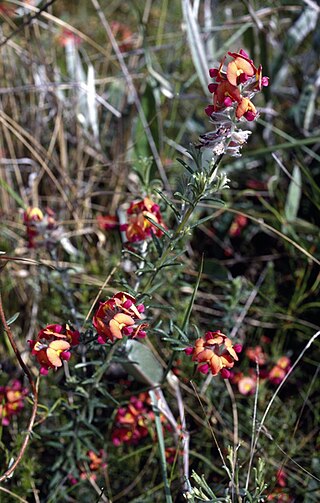
Chorizema cytisoides is a species of flowering plant in the family Fabaceae and is endemic to the southwest of Western Australia. It is an erect to low-lying or sprawling shrub with linear leaves and reddish-orange, yellow and purple flowers.
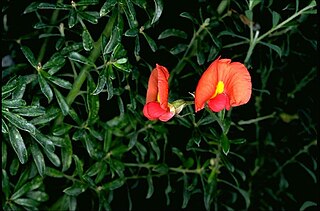
Chorizema dicksonii, commonly known as yellow-eyed flame pea, is a species of flowering plant in the family Fabaceae and is endemic to the southwest of Western Australia. It is an erect or spreading shrub with oblong to lance-shaped leaves and red and orange flowers.


















